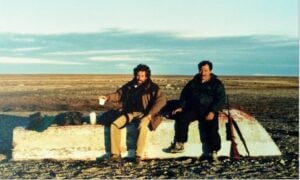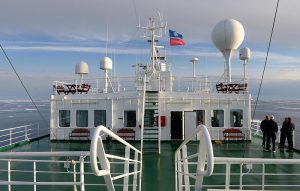
People & Culture
On thin ice: Who “owns” the Arctic?
As the climate heats up, so do talks over land ownership in the Arctic. What does Canadian Arctic Sovereignty look like as the ice melts?
- 4353 words
- 18 minutes
This article is over 5 years old and may contain outdated information.
History

The 2014 Victoria Strait Expedition is the most ambitious search for the lost ships of the Franklin Expedition to date, with more partners and more sophisticated technology than ever before. This August, an unprecedented number of public and private organizations will come together to search for artifacts from the 1845 expedition, exploring the sections of seabed where the ships were last seen for the first time, a task made impossible until now because of thick sea ice in the area.

The size of the mission and the cutting edge technology it will use mean that the partners have a better chance of finding the Erebus and Terror than ever before. Even if the search does not yield a major archaeological discovery, it’s sure to deepen our knowledge of Canada’s North and contribute to its communities.
The Victoria Strait Expedition will centre on four ships: the Canadian Coast Guard’s CCGS Sir Wilfrid Laurier, the Royal Canadian Navy’s HMCS Kingston, the Arctic Research Foundation’s research vessel Martin Bergmann, and One Ocean Expeditions’ One Ocean Voyager. Additionally, there are there smaller survey vessels that will collect side scan and multi beam sonar data: Parks Canadsa HMCS Investigator, and the Canadian Hydrographic Survey’s Gannett and Kinglet. Using sonar technology developed by Newfoundland’s Kraken Sonar Systems, the team will map the seabed in ultra high resolution while searching for evidence Franklin’s ships.
The Canadian-made Underwater Autonomous Vehicle Arctic Explorer will go where no AUV has gone before. Built by Port Coquitlam, BC’s International Submarine Engineering and deployed by Defence Research and Development Canada, the Arctic Explorer will dive beneath further beneath the ice than AUVs deployed on previous searches. Tracked by an acoustic homing system developed by Nova Scotia’s Omnitech Incorporated, it is capable of operating for days independently, exploring sections of seabed that were previously inaccessible because of ice cover. As it searches for Franklin’s ships, the Arctic Explorer will provide valuable research into the operation of sonar imaging technology in extreme water temperatures.
The Victoria Strait Expedition will even receive support from space. The Canadian Space Agency’s RADARSAT-2 satellite will provide satellite imagery of the area, enabling another partner, the Canadian Ice Service, to analyze the type, extent and movement of sea ice.
The satellite will also provide detailed images of uncharted shoreline, helping map the region for shipping. A remote region with a harsh climate, Canada’s Arctic remains relatively unknown, but more ships than ever are plying its waters, despite a lack of comprehensive hydrographic surveys. This maritime traffic is driving the need for nautical charts to decrease the risk of groundings, loss of life and environmental damage.
Ice and weather permitting, the team could significantly exceed the amount of ocean floor scanned and mapped during any previous expedition. Data collected by the Canadian Hydrographic Service this summer will be used to create the navigational charts mariners need to navigate Arctic waters safely.
In coming decades, the North promises to be even more important. International demand for resources, combined with new technology that makes developing the North’s resources feasible, will drive development in the region. Northerners, including Aboriginal peoples—who comprise the majority of the population in Nunavut—have more say in development than ever before, thanks to a series of devolution and land-claim agreements.
The Victoria Strait Expedition speaks to the North’s past and its future, and bringing both into perspective. Recovering artifacts from the Franklin Expedition sheds light on the search for the Northwest Passage, on the Arctic’s environment and on early contact between Inuit and Europeans.
During the 2014 expedition, a land-based archaeological team from Nunavut’s Department of Culture and Heritage will reinter remains exhumed for research purposes last year. The land-based team will conduct additional surveys and analyses of known archaeological sites.
The Royal Canadian Geographical Society (RCGS) will play a lead role in connecting the Victoria Strait Project to Canadians and geography enthusiasts from around the world. As Canada’s center for exploration, and leading proponent for geoliteracy, the RCGS will inform and educate Canadians about this year’s expedition, how it creates new opportunity to solve a great Canadian mystery, and how the search for Franklin’s lost ships has impacted our shared heritage.
With the strong support of its partners, including The W. Garfield Weston Foundation, One Ocean Expeditions, Shell Canada and the Arctic Research Foundation, the RCGS will develop and disseminate an educational program to Canadian schools, so that educators and students can develop stronger engagement with the Arctic and knowledge of how it has shaped Canadian history.
As a strong and generous supporter of scientific research in the North, The W. Garfield Weston Foundation is a valuable partner in the Victoria Strait Expedition. A catalyst in this summer’s search, the Foundation will collaborate with and support the Royal Canadian Geographical Society to support frontline research and create educational materials that will bring stories of Canada’s North to students across the country.
In recent years, The W. Garfield Weston Foundation has helped address the gap in discovery research in the North and is now among the largest private supporters of northern research in Canada. The foundation provides prestigious awards and fellowships to leading Canadian scientists, and enables northern research stations to offer critical support for field research.
Collaboration with Northern communities is an important facet of the Victoria Strait Project. Many of the partners will work with Northern communities to meet local needs. Some will contribute directly: The Arctic Research Foundation is building and outfitting a dedicated artist’s studio in Cambridge Bay, for example. Each year, the foundation overwinters its ship off Cambridge Bay. This makes it among the first boats able to travel to other Arctic communities when the ice begins to break up. In recent years, the ARF has helped Inuit quarry and transport local soapstone, the medium of choice for many carvers.
This year, the Arctic Research Foundation will also support a research project led by Queen’s University to study the feasibility of an Inuit-operated commercial fishery based in Gjoa Haven, promising to generate new knowledge of current subsistence-fishing practices and a potential commercial fishery.
Another intriguing component of the Victoria Strait Project involves One Ocean Expeditions. A Canadian tour operator founded in 2007, One Ocean operates cruises through the Arctic each summer with a leased European scientific ship. One Ocean replaces its scientific gear with Zodiacs and kayaks, hires experienced scientists, educators and guides—including interns from Nunavut Arctic College—and takes groups of up to 95 passengers on once-in-a-lifetime journeys through the North.
The trips are point-to-point; passengers fly into northern communities such as Resolute Bay, and are then ferried to the ship. One Ocean makes multiple stops, generating significant revenues for local communities. As part of the Victoria Strait Expedition, One Ocean will serve as a platform for 10 days, supporting the operations of Parks Canada, Defence Resarch and Development Canada and others.
Dozens of expeditions have searched for the wrecks of the Erebus and Terror, but this year’s team is the most ambitious ever. The odds of a find are better than ever, but even if neither of Franklin’s ships is located, the Victoria Strait Expedition will help northern communities and contribute to the Canada’s long-standing role in the exploration and development of its Arctic.
Are you passionate about Canadian geography?
You can support Canadian Geographic in 3 ways:

People & Culture
As the climate heats up, so do talks over land ownership in the Arctic. What does Canadian Arctic Sovereignty look like as the ice melts?

History
Arctic historian Ken McGoogan takes an in-depth, contemporary perspective on the legacy of Sir John Franklin, offering a new explanation of the famous Northern mystery

History
First official day of the 2014 search for Sir John Franklin’s lost ships

People & Culture
On April 12, Franklin enthusiasts had a rare opportunity to come together in the same room as The Royal Canadian Geographical Society presented their 2016 Can Geo Talks